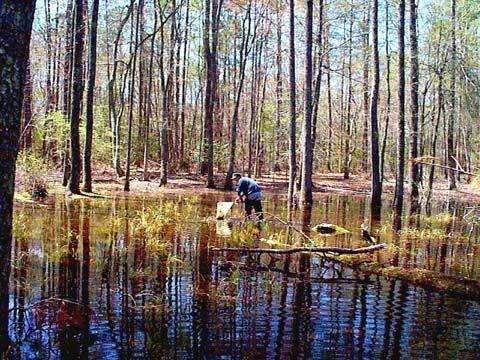
Charles D. Rafkind, NPS The lands of Colonial National Historical Park today bear little resemblance to the virgin forests of 1607 or the agricultural landscape of 1781. In his journals, Captain John Smith noted the dugout canoes of the Powhatan Indians were large enough to hold 40 people. Having been attracted by the heavy forests of pine, oak, maple, cedar, cypress, and beeches, the early settlers timbered almost all the mature trees to furnish themselves with wood for tools and homes. A few 300-year-old bald cypress trees were never harvested and still remain in remote wetlands. Today, younger descendents of these species still grow in the park. Three primary forest types exist: upland, hardwood wetlands, and successional. Much of the upland forests now consist of extensive stands of loblolly pines and oaks, hollies and beeches. Typical pine-oak forests are seen on Jamestown Island. Wetland forests of bald cypress, wax myrtle, and green ash grow in a few areas of the shoreline at Jamestown Island. This globally rare plant community occupies only a few very specialized habitats in Maryland and Virginia. Successional forests usually begin with seedling loblolly pine and sweet gum. Extensive stands of golden bamboo comprise exotic forests that have been planted or are naturalized in many areas of the park, usually on disturbed lands with moist soils. Densely vegetated with tall woody stems, such forests give few other plants enough space to grow. In autumn, groups of groundsel bush display clouds of cottony white seeds along the Colonial Parkway. Marsh elder and wax myrtle grow in the same habitat along the salty fringes of the York and James rivers. At Yorktown Battlefield and along the parkway at Kings Creek, deciduous sprouts from stumps and small trees represent regeneration of hardwood species on cleared areas. Red maple, mockernut hickory, and American hornbeam are often covered with woody cat briars, creating impenetrable thickets. Ravine slopes and bluffs within the park often display shell deposits from an ancient seabed. Where forests were bisected by the construction of the Colonial Parkway, soils with high levels of calcium are exposed. Tree species requiring limy soils such as chinkapin oak, southern sugar maple, and bitternut hickory are seen here.FOREST final Roger 9.5.2012 Red maple, wax myrtle, and swamp tupelo grow on Jamestown Island in semi-permanently flooded wetlands. Formerly tidal wetlands, but now cut off from tidal influence by roads or berms, most of these areas have sustained heavy damage from past hurricanes. |
Last updated: September 12, 2022
